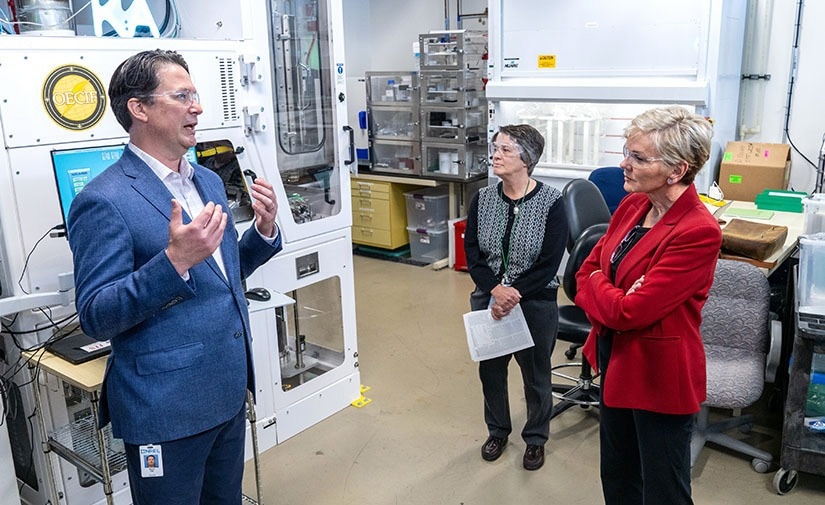Careful design of the materials in the cell stack allowed researchers at the National Renewable Energy Laboratory (NREL) of the US Department of Energy to extract a little more efficiency from their solar cells.
 Aaron Ptak, a senior scientist at NREL, provides an overview of the D-HVPE lab to Secretary of Energy Jennifer Granholm (right) and Nancy Haegel, director of the National Center for Photovoltaics at NREL. Ptak co-authored a newly published paper into improving the efficiency of III-V solar cells, which were made using the D-HVPE reactor. Image Credit: Werner Slocum, NREL
Aaron Ptak, a senior scientist at NREL, provides an overview of the D-HVPE lab to Secretary of Energy Jennifer Granholm (right) and Nancy Haegel, director of the National Center for Photovoltaics at NREL. Ptak co-authored a newly published paper into improving the efficiency of III-V solar cells, which were made using the D-HVPE reactor. Image Credit: Werner Slocum, NREL
The scientists used dynamic hydride vapor phase epitaxy (D-HVPE) to grow a gallium arsenide (GaAs) heterojunction solar cell with a certified efficiency of 27%, the highest rate of efficiency ever reported for a single-junction GaAs cell grown using this technique.
They did this by relying on both computational and experimental studies. The study represents the most recent attempt by NREL scientists to lower the cost of III-V solar cells for use in terrestrial applications.
The name III-V cells come from the position of the materials used to manufacture them on the periodic table of elements, and they are commonly employed to power space-faring technology. In comparison to existing approaches, D-HVPE has the potential to be a lower-cost method of producing these cells.
The recently published research lays out a strategy for enhancing solar cell performance by optimizing the doping and bandgap of a device layer known as the “emitter” to reduce the impact of flaws on device efficiency. The findings could be applied to materials other than III-Vs that use heterojunctions, such as silicon, cadmium telluride, or perovskites.
No matter how hard you try, with whatever method you choose to make them, solar cells will always contain some defects thanks to entropy. By using a heterojunction structure, with carefully designed emitter properties, you can minimize the adverse impact of these defects on efficiency, even though you haven’t done anything to reduce their concentration. Furthermore, the relative efficiency improvement scales with defect concentration. While the baseline D-HVPE cell already had a high efficiency, a device that had a higher defect concentration would receive a higher relative efficiency boost using the methods described in the paper.
Kevin Schulte, Study Lead Author and Scientist, High-Efficiency Crystalline Photovoltaics, National Renewable Energy Laboratory
The study, titled “Modeling and Design of III-V Heterojunction Solar Cells for Enhanced Performance,” was co-authored by NREL researchers John Simon, Myles Steiner, and Aaron Ptak.
The solar cell used a gallium indium arsenide phosphide (GaInAsP) emitter layer in addition to the GaAs base layer. The heterojunction is formed by the two distinct layers. The effect of altering the zinc doping density and bandgap of the emitter layer on cell efficiency was modeled by varying the relative amounts of gallium, indium, arsenic, and phosphorus during layer development. The modeling determined the best values for these two factors to improve device efficiency.
After that, the researchers manufactured cells under the modeling’s guidance and saw increases in efficiency that were predicted by the model. The GaInP emitter of the rear heterojunction solar cell that was utilized as a baseline had a reported efficiency of 26%.
Even though the rest of the device remained identical, the efficiency rose to 27% by decreasing the doping in the emitter and altering its composition from GaInP to the lower bandgap GaInAsP.
The advantages of heterojunctions are well recognized, but the researchers pointed out that there are only a few combinations in which III-V heterojunctions have been experimentally shown.
Schulte added, “We took this concept that was known but not quantified this way and mapped it out. We showed the modeling matches what we see experimentally, showing that it is a powerful tool for solar cell design.”
Journal Reference:
Schulte, K. L., et al. (2023) Modeling and Design of III-V Heterojunction Solar Cells for Enhanced Performance. Nature. doi:10.1016/j.xcrp.2023.101541
Source: https://www.nrel.gov/index.html